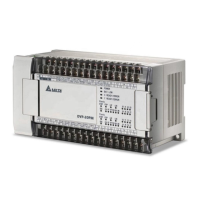9 Electronic Cam
9.6.2 Application of a Rotary Cutter
In the application of cutting materials on a feeding belt, a traditional approach is that a cutting roller will
rotate after a feeding roller rotates for a certain length, and the alternation of feeding materials and
cutting the materials is repeated. The disadvantage of this approach is that the
acceleration/deceleration needed in order for a feeding roller to rotate/stop decreases production
efficiency. As a result, a new approach is that materials are fed continuously. There are two ways of
cutting materials on a feeding belt. They are rotary cut and flying shear. Flying shear is reciprocating
motion, while rotary cut is unidirectional motion. The cam curve for rotary cut is different from the cam
curve for flying shear. In addition, thick material cutting also works in the same direction as rotary cut.
The difference between think material cutting and rotary cut is the electronic cam curve variation in
cutting process. Unlike the constant proportion curve of rotary cut’s sync area, the electronic cam curve
of thick material cutting varies during the cutting process between the start and the end of cutting. The
3 electronic cam applications are explained as below.
9.6.2.1 Operation of a Rotary Cutter
When the rotary cutter performs cutting action, the feeding conveyor does not slow down and stop.
When the cutter touches the material, the moving speed of cutter should be the same as that of the
feeding conveyor. If the cutter is slower than the conveyor, the material will be squeezed and piled; if
the cutter is faster than the conveyor, the material will be extended and damaged.
The operation and simple wiring of rotary cut is illustrated as below. Positions 1, 2, 3 and 4 respectively
indicate starting position, middle position, end position and ready position of speed synchronization.
When Master (Y axis) executes, Slave (X axis) accelerates from position 4 to position 1, reaching the
synchronizing speed. The sync speed is maintained from position 1 to position 3. After position3, Slave
decelerates and returns to position 4. The cycle repeats for continuous rotary cut operation.
1
2
3
SERVO
SERVO
20PM
CAM
X axis
Y axis
Jog
Encoder output
Cut Length
4
SERVO
SERVO
CAM
Jog
Cut Length
1
2
3
SERVO
SERVO
20PM
CAM
X axis
Y axis
Jog
Encoder output
Cut Length
4
SERVO
SERVO
CAM
Jog
Cut Length
DVP-20PM Application Manual
9-57

